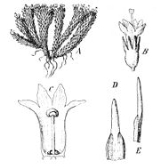
Phyllachne
Encyclopedia
Phyllachne is a genus of four cushion plant
species in the family Stylidiaceae
. Of the four species, two are endemic to New Zealand
, while P. colensoi
is also native to Tasmania
and P. uliginosa is entirely endemic to southern South America
and is the only species in the Stylidiaceae native to the Americas
. The movement of P. colensoi to colonize Tasmania is a relatively recent move. Molecular studies group P. colensoi, P. clavigera, and P. rubra together in one clade
with P. uliginosa in the sister clade. Based on molecular clock
data of the rbcL gene, it is estimated that P. uliginosa last shared a common ancestor with the New Zealand clade about 6 million years ago.
Cushion plant
A cushion plant is a compact, low growing, mat forming plant that is found in alpine, subalpine, arctic, or subarctic environments around the world...
species in the family Stylidiaceae
Stylidiaceae
The family Stylidiaceae is a taxon of dicotyledonous flowering plants. It consists of five genera with over 240 species, most of which are endemic to Australia and New Zealand. Members of Stylidiaceae are typically grass-like herbs or small shrubs and can be perennials or annuals...
. Of the four species, two are endemic to New Zealand
New Zealand
New Zealand is an island country in the south-western Pacific Ocean comprising two main landmasses and numerous smaller islands. The country is situated some east of Australia across the Tasman Sea, and roughly south of the Pacific island nations of New Caledonia, Fiji, and Tonga...
, while P. colensoi
Phyllachne colensoi
Phyllachne colensoi, the yellow cushionplant, is a species of cushion plant in the Stylidiaceae family. It is native to both New Zealand and Tasmania, with colonisation of the latter being a somewhat recent dispersal...
is also native to Tasmania
Tasmania
Tasmania is an Australian island and state. It is south of the continent, separated by Bass Strait. The state includes the island of Tasmania—the 26th largest island in the world—and the surrounding islands. The state has a population of 507,626 , of whom almost half reside in the greater Hobart...
and P. uliginosa is entirely endemic to southern South America
South America
South America is a continent situated in the Western Hemisphere, mostly in the Southern Hemisphere, with a relatively small portion in the Northern Hemisphere. The continent is also considered a subcontinent of the Americas. It is bordered on the west by the Pacific Ocean and on the north and east...
and is the only species in the Stylidiaceae native to the Americas
Americas
The Americas, or America , are lands in the Western hemisphere, also known as the New World. In English, the plural form the Americas is often used to refer to the landmasses of North America and South America with their associated islands and regions, while the singular form America is primarily...
. The movement of P. colensoi to colonize Tasmania is a relatively recent move. Molecular studies group P. colensoi, P. clavigera, and P. rubra together in one clade
Clade
A clade is a group consisting of a species and all its descendants. In the terms of biological systematics, a clade is a single "branch" on the "tree of life". The idea that such a "natural group" of organisms should be grouped together and given a taxonomic name is central to biological...
with P. uliginosa in the sister clade. Based on molecular clock
Molecular clock
The molecular clock is a technique in molecular evolution that uses fossil constraints and rates of molecular change to deduce the time in geologic history when two species or other taxa diverged. It is used to estimate the time of occurrence of events called speciation or radiation...
data of the rbcL gene, it is estimated that P. uliginosa last shared a common ancestor with the New Zealand clade about 6 million years ago.

